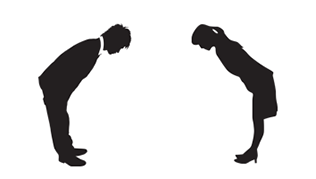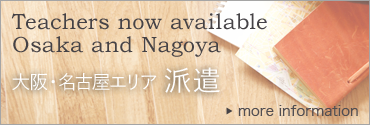お辞儀 (Bowing)

Introduction
Bows are more traditional greeting in Japan than any other East Asian countries.
Shaking hands is not common in Japan. The Japanese greet each other by bowing
Bowing is performed not only for greeting, but also for expressing different emotions including respect, apologies and gratitude. Bows are made in various traditional settings such as tea ceremony and martial arts. Bows are performed with the back straight and the hands at the sides, and with the eyes down. Bows form at the waist. Normally, the longer and deeper the bow, the stronger the emotion. Generally, an inferior bows longer and more deeply, and more often than a superior.
But since foreigners are not expected to know proper bowing rules, just nodding your head is usually sufficient.
Bows in daily life
Bows are usually conducted at a time of both meeting and parting. Bows almost unconsciously occur with the greeting phrases like “kon-nichiwa” 「こんにちは」, “ogenkidesuka”「お元気ですか」,“ja-mata”「じゃあ、また」 ,but are no longer used among the family members.
Bowing slightly is done before and after a meal as follows:
Before a meal, bow slightly with two hands placed on the lap while mentioning a simple phrase * “itadaki-masu” 「いただきます。」
After a meal, bow slightly with two hands placed on the lap while mentioning a simple phrase ** “gochiso-sama “「ごちそうさま。」
* itadaki-masu : “itadaku” is a humble form of taberu (to eat)
**gochiso-sam : “go” is a prefix .” chiso” is a feast. “sama” is a suffix
Bows of apology
Bows of apology tend to occur frequently during the apology, generally at about 45 degrees with the head lowered and to last for at least the count of three.
Unfortunately bows of apology nowadays are frequently seen in Japan, performed at press conferences by high-ranking members of a leading company when the company has committed some wrongdoing. Such bows are always conducted standing behind a table.
Bows martial arts: Aikido, Kendo, Karate, Judo, etc.
Bowing is an essential part of traditional martial arts. Bows are conducted at the beginning and the end of the practice, and also when entering and leaving the dojo or practice room. This is the standard among practitioners in any country.
Bows in religious settings
Bows are conducted both in Shinto shrines and Buddhist temples. Visitors to a Shinto shrine will bow, clap their hands twice in prayer and then bow again.
Visitors to Buddhist temples will put their hands together and bow.
Bowing in tatami rooms
In tatami rooms, bow is performed by getting down on the knees and touching the palms to the floor. Such a bow can be frequently seen performed by the help at a Japanese style restaurant or inn to welcome the customers.
Do you prefer having lessons at your own place at your own convenience?
NIC can dispatch Japanese teachers.
Do you prefer having lessons at your own place at your own convenience?
NIC can dispatch Japanese teachers.





 Contact us
Contact us 03-3454-5002
03-3454-5002 Application Form
Application Form



